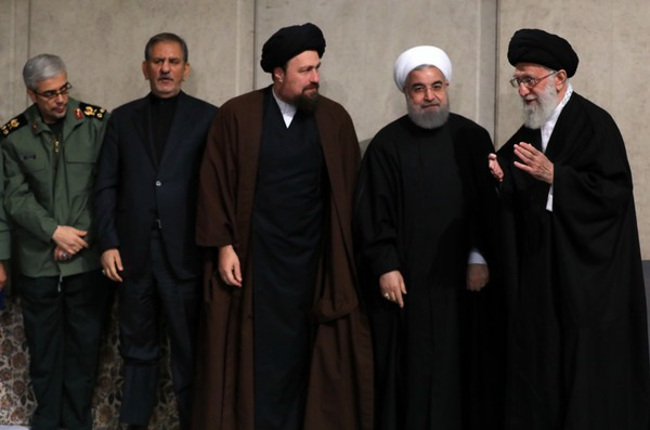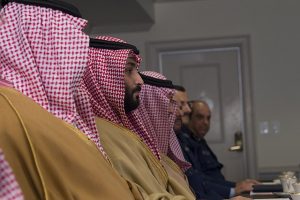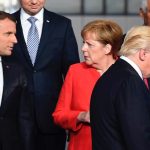by Emile Nakhleh
In the past quarter century, the United States and its Western allies have suffered much from terrorism, mostly perpetrated by Sunni extremists. America has spent billions of dollars fighting al-Qaeda and its affiliated groups and more recently the Islamic State (ISIS or IS) with little to show for it. Washington has forged new counterterrorism alignments with several Sunni leaders—Arab and non-Arab—across the greater Middle East to contain the threat of terrorism, again to no avail. President Trump’s recent visit to Saudi Arabia and his meetings with the mostly Sunni heads of Arab and Muslim countries are the latest examples of Washington’s feverish pursuit of alliances to fight radicalism and extremism.
As these policies have failed to “drain the swamp” of terrorism, the Trump administration should perhaps relax its embrace of Sunni regimes and partner with non-Sunni, Shia Iran in this seemingly endless war. Sadly, despite American huge losses in lives and treasure, al-Qaeda and its affiliates have surged, and IS has expanded its terror campaign across the Middle East, South Asia, and Europe.
A rational examination of this arguably outside-the-box policy option requires that American senior policymakers have a clear-eyed knowledge of what drives terrorism, its sources of support, the role Sunni extremism plays in the proselytization of terrorism, Iran’s relations with terrorist groups and organizations, and the differences between Sunni and Shia Islam on Islamic extremism and radicalism. If President Trump and his policy and intelligence advisers are serious about implementing the “principled realism” approach he outlined in Riyadh, he should seriously consider this recommendation and not reject it out of hand because of perceived political expediency.
Iran, a non-proselytizing Shia state with its own set of interests, might be willing—or incentivized—to play a critical role in counterterrorism, which in the end serves American national interest and security as well as regional stability.
The so-called Arab NATO under Saudi leadership will not enhance or augment America’s anti-terrorism fight. This aspirational Gulf grouping—much like its miniature version, the Gulf Cooperation Council—is directed against Iran, designed to preserve authoritarian rule, and dedicated to the preservation of family rule in the Gulf Arab states at the expense of their peoples’ liberty and human rights. It’s also a bonanza for American and Western manufacturers of arms and war materiel. If the bloody and hopeless Saudi war in Yemen is any indication, the “Arab NATO” aims to challenge Iran and perhaps drag it into war with Sunni Islam, as defined and protected by Saudi Arabia. Nor will it contribute to regional stability and security because of its tangential interest in countering violent Sunni extremism.
The United States should not be duped into supporting such a regional arrangement just because of potentially hefty arms sales. Taking sides in the perennial sectarian feud between Sunni and Shia Islam or between Saudi Arabia and Iran is, in the long run, inimical to American national security and interests in the Islamic world. Successive American presidents since Dwight Eisenhower have wisely pursued policies in the Persian Gulf region that promoted rapprochement, not conflict, between Iran and its important neighbor on the Arab littoral of the Gulf. That was the underpinning of the “security belt” in the Gulf from the 1950s to the late 1970s and should remain so today.
Sources of Terrorism: Back to Basics
Understanding what drove Osama bin Laden and al-Qaeda in the past 25 years and IS since then is not rocket science or an incomprehensible mystery. Policy and intelligence analysts over the years have codified the factors that drive terrorist groups, their religious underpinnings and major sources of terrorist funding, the countries from which most terrorist recruits come, and the worldview they espouse.
Over the years, American intelligence and policy analysts worked with their counterparts from Commonwealth countries—Britain, Canada, Australia, and New Zealand—and others on these issues and generally reached a consensus on what works and doesn’t work. Policymakers in these countries were always apprised of the results of these transnational deliberations. Unfortunately, ensuing policies toward terrorism only partially considered the recommendations and briefings offered by policy and intelligence analysts. Drivers of extremism generally fall into two categories: radical religious ideology and authoritarian regime policies of repression, corruption, and joblessness.
Most terrorists are Sunni Muslims. Their religious justification for violence, including beheadings, is embedded in extremist Sunni interpretations of Islam—Hanbali, Wahhabi, Salafi—prevalent mostly in Saudi Arabia and other Gulf countries. Extremists and much of their funding have mostly come from these same countries. Of course, extremists have also hailed from other Muslim states, including Egypt, Yemen, North Africa, South Asia, the Balkans, Central Asia, and elsewhere. Additionally, several thousand radicals are citizens of Western countries, including the United States.
Unlike Shia Islam, the Saudi brand of Sunni Islam proselytizes aggressively through Koranic schools, community projects, Saudi-supported private organizations, the building of mosques, and the distribution of free Korans. The Saudis have given thousands of scholarships to Muslim youth from across the Muslim world to study in Saudi universities, such as Imam Muhammad in Riyadh, Um al-Qura in Mecca, and the Islamic University in Medina. In the 1990s, for example, the Saudis competed with Iran and Turkey to win the “hearts and minds” of Muslims in the post-Soviet Uzbekistan, Turkmenistan, Tajikistan, and Kazakhstan. The Saudis won converts primarily because of their funding of mosques and schools. Whereas the regimes in those countries resented what they called “Wahhabi activism,” that brand of Islam took root in Central Asia.
Similar competition occurred in the 1990s and early 2000s between the Saudi and Iranian brands of Islam in northern Nigeria and the Sahel countries. Saudi Islam emerged preeminent in that part of Africa, again because of Saudi economic largesse. During that period big signs graced the walls of the one-room Koranic schools that identified the Saudi sponsors, Islamic non-governmental organizations such as the International Islamic Relief Organization (IIRO), the World Assembly of Muslim Youth (WAMY), the Muslim World League, and al-Haramayn. Since then, but especially since the terrorist attacks inside Saudi Arabia, the Saudi government disavowed some of these organizations and began to distance itself from others.
The force multiplier of Sunni proselytization was evident in the hundreds of students who went to Saudi Arabia to study on scholarships and who returned to their countries to teach and preach. Although the Saudi government today views Sunni extremism and terrorism as a threat, much of the Islamic world and some European countries still feel the cascading influence of Wahhabi-Salafi proselytization from a generation ago. Middle school and secondary school textbooks in Koranic and Hadith studies, Islamic history, and jurisprudence in many Muslim countries continue to reflect the Saudi-condoned Salafi interpretation of Islam. In addition, hundreds of thousands of Saudi-printed Korans, which contain exegesis favorable to the same interpretation, have been distributed free of charge throughout the Sunni Muslim world.
Arab Regime Policies on Terrorism
Arab Sunni autocrats and potentates often spout anti-terrorism words that are music to American ears but provide only lukewarm operational support for counter-terrorism policies. For their comforting language, they are sold or given arms worth billions of dollars. Their policies of repression and corruption have resulted in inadequate education, high unemployment and underemployment (especially among the 18-29 cohort), and alienation and frustration among young men and women. Many unemployed, angry youth in these countries become radicalized, are recruited for extremist causes, and subsequently engage in terrorism.
The UNDP-sponsored Arab Human Development annual reports since 2002, including the most recent one in 2016, have highlighted the “deficits” of freedom, women’s empowerment, and knowledge, and urged Arab governments to address them. Other deficits also include a lack of innovation, creativity, and job-creation entrepreneurial initiatives. Ossified, draconian legal restrictions have been put in place to stifle youth creativity, the freedom to innovate, and the ability to seek international funding for job creation and technology-based entrepreneurial start-ups. Although the 2016 Arab Human Development Report shows some hopeful indicators about the youth, it continues to lament Arab regimes’ inability or unwillingness to address the grievances of their people.
To suppress their populace even further, Arab regimes have promulgated so-called terrorism laws restricting all facets of political, social, and legal peaceful activism. Many moderate opposition figures and groups—Islamic and secular—have been tried and convicted under the myriad of recent terrorism laws. Some have been deprived of their citizenship and deported. In the last week of May, a Bahraini court decided to dissolve al-Waad, a secular human rights group, which has been committed to non-violent and lawful political reform. It’s the latest sign of repression that the Al Khalifa ruling family has imposed on its people. Egypt and Saudi Arabia have pursued similar policies. All in the name of fighting terrorism!
Iran and Terrorism
Although Iran has supported Sunni and Shia terrorist organizations over the years, it has done so not for proselytization but in the service of its national interest. Supporting proxy terrorist groups has been a principle of Iran’s security doctrine for years, especially during the period when Iran was threatened with the possibility of regime change. The Iranian funded semi-government Shia organization, Ahl al-Bayt, was used by the clerical regime to compete with Saudi-funded Sunni organizations in the battle for the hearts and minds of Muslims globally. Years ago, I observed such competition closely in Africa, Central Asia, and the Balkans, and concluded that Saudi Arabia would win the competition handily. Money and proselytization contributed to Saudi Arabia winning this “public diplomacy” battle. Sunni Islam proselytizes; Shia Islam does not.
Right after 9/11, Iran worked closely with the United States in the war against al-Qaeda in South Asia and in Iraq after the 2003 invasion and the toppling of Saddam Hussein. Furthermore, Iran has had successive elections, which resulted in electing relatively moderate presidents. Public opinion polls have frequently shown that Iranian youth generally have a favorable opinion of America and desire to open contacts with the West. Undeterred by the ruling theocracy, Iranian youth vibrantly produce movies, music, and publish books and magazines. Almost nothing like this exists across the water in Saudi Arabia.
Despite opposition from the radical elements in Iran, the regime signed a deal that severely limits the country’s nuclear program. The deal followed lengthy secret talks with the United States. Through a tight inspections regime, Iran is banned from producing highly enriched uranium and weapon-grade plutonium, essentially blocking its path to a nuclear weapon. Iran signed the deal while major US and international sanctions remain in place.
Iran knows that to re-enter the international community, it must limit its missile production, halt its sponsorship of terrorism, dramatically improve its human rights record, and curtail its destabilizing activities in the region. Although Iran continues to support the Houthis in Yemen, Hezbollah in Lebanon, and the Assad regime in Syria, it opposes Sunni extremism and terrorism. The recent re-election of president Hassan Rouhani signals the Iranian state’s willingness to partner with the international community in the fight against al-Qaeda, IS, and other terrorist organizations. The Trump administration should take Iran up on the offer.
Photo: Memorial service for Akbar Hashemi Rafsanjani with Ali Khamenei at far right and Hassan Rouhani next to him.





